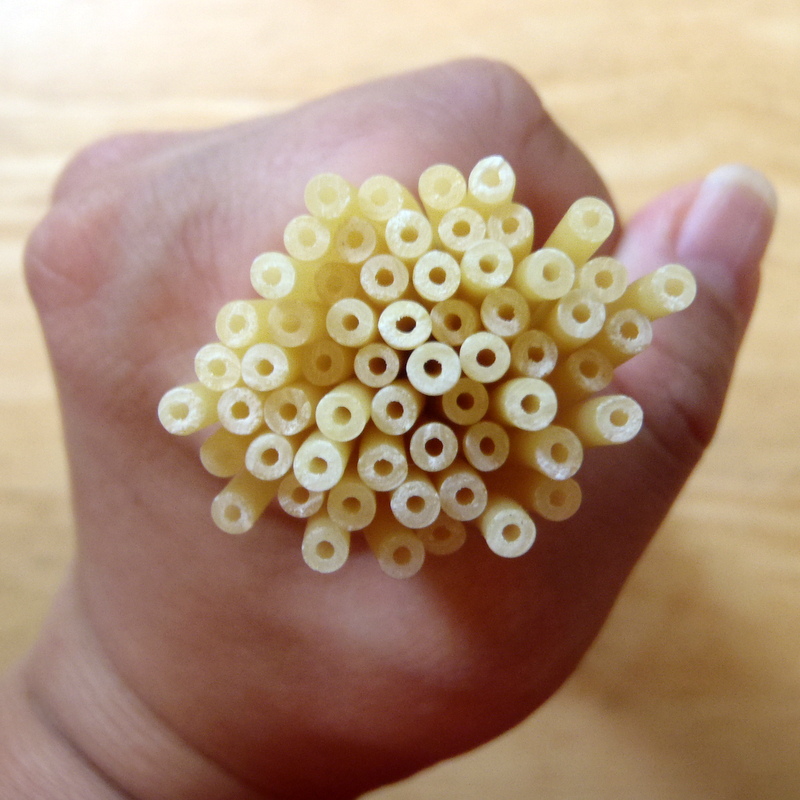
One stroll down your local grocer’s pasta aisle, and you’ll be quickly, startlingly reminded of just how many pasta shapes there are. According to Italy Magazine, there are an estimated 350 different types of pasta, and about four times that many names for them. Needless to say, we’d love to cover them all, but an article addressing each and every pasta shape might prove a bit excessive.
The world of Italian pasta is an extensive one that would take months to dissect properly. We could spend days on gnocchi alone, and months on the beautiful madness that is stuffed pastas. Ravioli, tortellini, lasagna, and cannelloni are each individually deserving of their own articles. As it is, though, in the American market, there seems to be a bit of confusion around some of the more common dried pasta shapes and how they’re best used. We’ve chosen a dozen of our very favorite, most commonly found pasta shapes to discuss here.
Bucatini

This pasta has all but replaced spaghetti in my household. Sure, spaghetti is a classic (more on this in a moment), but bucatini is basically improved spaghetti, in my opinion. Bucatini has all of the wonderful length and leggy texture of spaghetti but with an added hollow center for soaking up sauce.
Use bucatini anywhere you might use spaghetti for an instant upgrade.
Rigatoni

This tube-shaped pasta is absolutely brilliant at soaking up chunky, meaty sauces like ragus and bolognese. We love its ability to withstand heartier dishes and serve as a vessel for all of those rich ingredients.
Farfalle

Otherwise known as bowtie pasta, farfalle is, charmingly, the Italian word for “butterfly,” which we like much more than bowtie. This darling pasta shape is excellent in both warm and cold preparations and is best served in lighter, creamy sauces and dressings.
Spaghetti

Arguably the most famous pasta shape of all time, spaghetti is likely the noodle that comes to mind when one even thinks of the word “pasta.” Spaghetti’s long and thin strings are most famous for their role in everyone’s favorite Italian dish – spaghetti and meatballs – but is an extremely versatile pasta that sings in just about everything from lighter, oil-bases sauces to thicker, heartier meat sauces.
Orzo

Orzo is having a moment in the sun right now, and we are here for it. This deliciously small and rice-shaped pasta can be used in soups, salads, and almost anywhere you might use rice. We love a chilled pesto orzo salad.
Shells

This nostalgic seashell shape is perfect for creamy sauces and small ingredients that may accompany them, like peas and other small-diced vegetables. The concave shape of the shell helps to carry heartier sauces, too, so don’t let these delicate-looking shells shy away from a hearty ragu.
Ditalini

These teeny tubes are perfect in everything from hot soups like minestrone to cold pasta or even egg salads.
Macaroni

If you have kids, this is a pasta shape you know well for its ability to both satisfy a whining child and decorate your refrigerator along with construction paper and accented with copious amounts of glitter.
But this popular pasta shape is so much more than blue boxes and arts and crafts. These versatile little shapes are excellent in creamy (yes, cheesy) sauces as well as tomato-based sauces and pasta salads.
Lasagna

We know this pasta shape best for its namesake dish, lasagna. And while we can get creative with our lasagna recipes, making everything from a traditional meat sauce and cheesy layered masterpiece to a vegetable lasagna with pesto, lasagna is but one of the many possibilities for this surprisingly versatile pasta shape.
Spread these noodles with your favorite filling and bake for a different take on the traditional lasagna dish, or go ahead and break the sheets up and put them into a soup for a rustic, more artistic look. There aren’t any rules, so have fun.
Cavatappi

This corkscrew-shaped pasta is almost as fun to look at as it is to eat. The springy, hollow shape of cavatappi makes it sturdy enough to take on even the heartiest, meatiest sauces and soak up every single ounce of flavor possible. If you’re feeling a bit less traditional, set the macaroni aside and use this in your cheesy pastas.
Pappardelle

This traditional Tuscan pasta shape is comprised of wide, ribbon-like strands and is made with egg yolk, often giving it an attractive golden color. Pappardelle ribbons are just wide enough to grab hold of hearty creamy or meaty sauces, while still having a delicacy to their consistency.
Orecchiette

While orecchiette literally means “little ears,” this pasta has always reminded me of tiny hats. Whichever visual you prefer, this adorable pasta shape makes for the perfect scoop for other ingredients like beans, vegetables, or bits of meat sauce. Orecchiette is also wonderful in a pasta salad.



